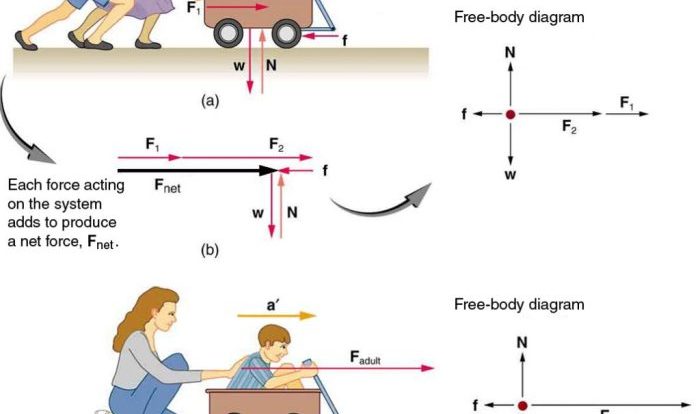Lab calorimetry and specific heat stand at the forefront of this exploration, shedding light on the intricate dance between heat and matter. As we delve into the depths of this topic, we’ll unravel the mysteries of calorimetry and uncover the significance of specific heat, promising an enlightening journey through the realm of thermal energy.
Specific heat, a substance’s unique fingerprint, unveils its capacity to absorb and release heat. Calorimetry, the art of measuring heat changes, empowers us to quantify these thermal interactions. Together, they form an indispensable duo in diverse fields, from chemistry and physics to biology and engineering.
Introduction
Calorimetry is the study of heat transfer and its relation to various physical and chemical changes. Specific heat, on the other hand, is a measure of the amount of heat energy required to raise the temperature of one gram of a substance by one degree Celsius or Kelvin.
Calorimetry and specific heat are closely related concepts. Calorimetry provides the means to measure the heat transfer involved in various processes, while specific heat determines the amount of heat required to cause a specific temperature change in a given substance.
Relationship between Calorimetry and Specific Heat
The relationship between calorimetry and specific heat can be expressed mathematically as follows:
Q = mcΔt
where:
- Q is the heat transferred (in joules)
- m is the mass of the substance (in grams)
- c is the specific heat of the substance (in joules per gram per degree Celsius or Kelvin)
- Δt is the change in temperature (in degrees Celsius or Kelvin)
This equation shows that the heat transferred to or from a substance is directly proportional to its mass, specific heat, and the change in temperature.
Lab Calorimetry Methods
Lab calorimetry is a technique used to measure the amount of heat transferred during a chemical reaction or physical change. Calorimetry experiments can be used to determine the specific heat of a substance, the enthalpy of a reaction, and other thermodynamic properties.
There are two main types of calorimetry methods: constant-volume calorimetry and constant-pressure calorimetry. Constant-volume calorimetry is used to measure the heat transferred at constant volume, while constant-pressure calorimetry is used to measure the heat transferred at constant pressure.
Constant-Volume Calorimetry
In constant-volume calorimetry, the reaction or physical change is carried out in a sealed container. The heat transferred to or from the system is measured by the change in temperature of the container and its contents.
Constant-Pressure Calorimetry
In constant-pressure calorimetry, the reaction or physical change is carried out in an open container. The heat transferred to or from the system is measured by the change in temperature of the surrounding environment.
| Method | Applications |
|---|---|
| Constant-volume calorimetry |
|
| Constant-pressure calorimetry |
|
Specific Heat Calculations
Specific heat is a measure of the amount of heat energy required to raise the temperature of a substance by one degree Celsius. It is an intensive property, meaning that it does not depend on the amount of substance present.
The specific heat of a substance can be calculated using the following formula:
$C_p = \fracQm \Delta T$
where:
- $C_p$ is the specific heat in J/g°C
- $Q$ is the heat energy transferred in J
- $m$ is the mass of the substance in g
- $\Delta T$ is the change in temperature in °C
Examples of Specific Heat Calculations
Here are some examples of specific heat calculations:
- To raise the temperature of 100 g of water by 10 °C, 4184 J of heat energy is required. The specific heat of water is therefore:
$C_p = \frac4184 J100 g \times 10 °C = 4.184 J/g°C$
- To raise the temperature of 100 g of aluminum by 10 °C, 2093 J of heat energy is required. The specific heat of aluminum is therefore:
$C_p = \frac2093 J100 g \times 10 °C = 0.2093 J/g°C$
Applications of Specific Heat
Specific heat has many applications in the real world, including:
- Heating and cooling systems:The specific heat of a substance can be used to calculate the amount of heat energy required to heat or cool a room or building.
- Cooking:The specific heat of food can be used to calculate the amount of time required to cook it.
- Materials science:The specific heat of a material can be used to determine its thermal conductivity and other properties.
Applications of Calorimetry and Specific Heat
Calorimetry and specific heat find widespread applications in various scientific disciplines and industries. Their ability to measure heat flow and determine the thermal properties of substances makes them invaluable tools for understanding and manipulating energy transfer.
In scientific research, calorimetry plays a crucial role in:
- Chemical reactions:Measuring the heat released or absorbed during chemical reactions provides insights into their thermodynamics and kinetics.
- Phase transitions:Calorimetry helps determine the energy required for substances to change phases (e.g., melting, freezing, vaporization).
- Biological processes:Calorimeters are used to study metabolic reactions and energy expenditure in living organisms.
Industries also heavily utilize calorimetry and specific heat for various purposes:
- Food industry:Calorimetry is essential for determining the nutritional value of foods and optimizing food processing.
- Pharmaceutical industry:Calorimetry aids in drug development and testing, ensuring drug stability and efficacy.
- Construction industry:Specific heat measurements help design energy-efficient buildings by determining the thermal insulation properties of materials.
- Environmental science:Calorimetry is used to study heat transfer in ecosystems and assess the impact of human activities on the environment.
The applications of calorimetry and specific heat extend far beyond these examples, showcasing their versatility and importance in numerous scientific and industrial domains.
Factors Affecting Specific Heat
The specific heat of a substance is not fixed and can vary depending on several factors. Understanding these factors is crucial for accurate calorimetry and heat transfer calculations.
Temperature
Specific heat can change with temperature. For most substances, specific heat increases with temperature, meaning they require more energy to raise their temperature by the same amount at higher temperatures. However, some substances, like water, exhibit the opposite behavior and have a specific heat that decreases with increasing temperature.
Phase, Lab calorimetry and specific heat
The phase of a substance, such as solid, liquid, or gas, significantly affects its specific heat. Generally, solids have lower specific heats than liquids, and liquids have lower specific heats than gases. This is because the molecules in gases are more spread out and have more energy, while molecules in solids are more tightly packed and have less energy.
Molecular Structure
The molecular structure of a substance also influences its specific heat. Substances with more complex molecular structures tend to have higher specific heats because more energy is required to break the bonds between the molecules.
Experiment to Investigate Factors Affecting Specific Heat
An experiment can be designed to investigate the factors affecting specific heat by measuring the temperature change of a known mass of a substance when it absorbs or releases a known amount of heat.
Variables to consider include:
- Substance type
- Initial and final temperatures
- Mass of the substance
- Amount of heat transferred
By controlling these variables and measuring the temperature change, the specific heat of the substance can be calculated and compared under different conditions.
Advanced Calorimetry Techniques
Advanced calorimetry techniques provide precise measurements of heat flow and enable the study of complex thermal processes. Two prominent techniques are differential scanning calorimetry (DSC) and isothermal titration calorimetry (ITC).
Differential Scanning Calorimetry (DSC)
DSC measures the difference in heat flow between a sample and a reference material as they undergo a temperature change. It detects thermal transitions such as melting, crystallization, and glass transitions.
- Advantages:
- High sensitivity and resolution
- Can identify and quantify thermal events
- Provides information on phase transitions and enthalpy changes
- Disadvantages:
- Requires a small sample size
- May not be suitable for samples with high thermal conductivity
Isothermal Titration Calorimetry (ITC)
ITC measures the heat released or absorbed during a chemical reaction or binding event. It is used to study protein-ligand interactions, enzyme kinetics, and drug-target binding.
- Advantages:
- Direct measurement of binding affinity and enthalpy
- Can provide information on binding stoichiometry and kinetics
- Suitable for studying complex biological systems
- Disadvantages:
- Requires purified proteins or ligands
- May not be sensitive enough for weak interactions
| Technique | Principle | Applications |
|---|---|---|
| DSC | Heat flow difference measurement | Thermal transitions, enthalpy changes |
| ITC | Heat release/absorption measurement | Binding interactions, enzyme kinetics |
Calorimetry in Thermodynamics: Lab Calorimetry And Specific Heat
Calorimetry plays a crucial role in thermodynamics by providing experimental methods to measure and quantify heat transfer and energy changes in thermodynamic processes.
Calorimeters, specialized devices used in calorimetry, enable researchers to determine thermodynamic properties such as specific heat, enthalpy, and internal energy of substances.
Calorimetry and Thermodynamic Properties
- Specific heat:Calorimetry can be used to measure the specific heat of a substance, which is the amount of heat required to raise the temperature of 1 gram of the substance by 1 degree Celsius.
- Enthalpy:By measuring the heat released or absorbed during chemical reactions or phase transitions, calorimetry can be used to determine the enthalpy change associated with these processes.
- Internal energy:Calorimetry can also be used to determine the internal energy of a system by measuring the heat transfer between the system and its surroundings.
Calorimetry in Thermodynamic Processes
- Adiabatic processes:Calorimetry can be used to study adiabatic processes, where no heat is transferred between the system and its surroundings. By measuring the temperature change of the system, the work done during the process can be calculated.
- Isothermal processes:Calorimetry can also be used to study isothermal processes, where the temperature of the system remains constant. By measuring the heat transferred during the process, the entropy change of the system can be calculated.
- Phase transitions:Calorimetry is commonly used to study phase transitions, such as melting, freezing, and vaporization. By measuring the heat absorbed or released during these transitions, the enthalpy change associated with the phase change can be determined.
User Queries
What is the difference between heat and temperature?
Heat is the transfer of thermal energy between objects, while temperature measures the average kinetic energy of the particles within an object.
How is specific heat calculated?
Specific heat is calculated by dividing the amount of heat absorbed or released by a substance by its mass and the change in temperature.
What are some applications of calorimetry?
Calorimetry finds applications in determining the energy content of foods, studying chemical reactions, and measuring the specific heat of materials.




